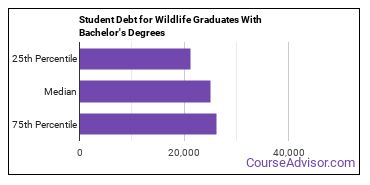Bachelor’s Degrees in Wildlife Management
Featured schools near , edit
Education Levels of Wildlife Majors
During the 2020-2021 academic year, 1,716 students earned their bachelor's degree in wildlife. This makes it the 139th most popular bachelor's degree program in the country.
The following table shows the number of diplomas awarded in wildlife at each degree level.
| Education Level | Number of Grads |
|---|---|
| Bachelor’s Degree | 1,716 |
| Basic Certificate | 205 |
| Master’s Degree | 200 |
| Associate Degree | 200 |
| Graduate Certificate | 67 |
| Doctor’s Degree | 56 |
| Undergraduate Certificate | 5 |
Earnings of Wildlife Majors With Bachelor’s Degrees
The median salary for graduates holding a bachelor's degree in wildlife is $26,124. A lot of factors can contribute to this number, such as the location of your workplace and the availability of other perks and bonuses. To get a better picture, earnings for this category of people can range from a low of $24,047 to a high of $27,924.

Student Debt
The median student debt for graduates holding a bachelor's degree in wildlife is $25,000. The school you go to and how long it takes you to graduate, among other things, can cause this number to vary. The chart below shows the range of accumulated debt loads. On the high side of the range, $26,250 is the debt load, and the debt load on the low side is $21,250.

The median monthly payment of a wildlife graduate with a 10-year repayment plan is $318.
Student Diversity
More women than men pursue their bachelor's degree in wildlife. About 54.1% of graduates with this degree are female.
| Gender | Number of Grads |
|---|---|
| Men | 787 |
| Women | 929 |

The racial-ethnic distribution of wildlife bachelor’s degree students is as follows:
| Race/Ethnicity | Number of Grads |
|---|---|
| Asian | 25 |
| Black or African American | 25 |
| Hispanic or Latino | 168 |
| White | 1,368 |
| International Students | 10 |
| Other Races/Ethnicities | 120 |

Most Popular Wildlife Programs for Bachelor’s Degrees
There are 60 colleges that offer a bachelor’s degree in wildlife. Learn more about the most popular 20 below:
Humboldt State University tops the list of the most popular school in the U.S. for wildlife majors who are seeking their bachelor's degree. Each year, around 6,600 students seeking various degrees attend the university. The average in-state tuition for full-time undergraduates is $5,742 per year, while in-state graduate students, on average, pay $7,176 per year. The wildlife program at Humboldt State University awarded 96 bachelor's degrees during the 2020-2021 school year. About 58% of this group were women, and 39% were students from an underrepresented racial-ethnic group.
Tarleton State University comes in at #2 on our list of the most popular colleges offering bachelor's degrees in wildlife. Each year, around 14,000 students seeking various degrees attend the university. The average in-state tuition for full-time undergraduates is $4,416 per year, while in-state graduate students, on average, pay $4,356 per year. For the 2020-2021 academic year, 89 bachelor's degrees were handed out to wildlife majors at Tarleton. About 60% of this group were women, and 20% were students from an underrepresented racial-ethnic group.
University of California - Davis comes in at #3 on our list of the most popular colleges offering bachelor's degrees in wildlife. Roughly 39,000 attend the school each year. The average in-state tuition for full-time undergraduates is $11,442 per year, while in-state graduate students, on average, pay $11,442 per year. The wildlife program at University of California - Davis awarded 88 bachelor's degrees during the 2020-2021 school year. Around 45% of these students were from an underrepresented racial-ethnic group, and 80% were women.
West Virginia University is the 4th most popular school in the nation for students seeking a bachelor's degree in wildlife. Roughly 26,200 attend the school each year. The average in-state tuition for full-time undergraduates is $9,144 per year, while in-state graduate students, on average, pay $10,332 per year. The wildlife program at West Virginia University awarded 67 bachelor's degrees during the 2020-2021 school year. Of these students, 48% were women and 6% were members of underrepresented racial-ethnic groups.
University of Wisconsin - Stevens Point is the 5th most popular school in the nation for students seeking a bachelor's degree in wildlife. Each year, around 8,300 students seeking various degrees attend the university. The average in-state tuition for full-time undergraduates is $6,698 per year, while in-state graduate students, on average, pay $8,066 per year. During the 2020-2021 academic year, 65 people received their bachelor's degree in wildlife from UW - Stevens Point. Around 8% of these students were from an underrepresented racial-ethnic group, and 54% were women.
The University of Montana is the 6th most popular school in the nation for students seeking a bachelor's degree in wildlife. Each year, around 9,800 students seeking various degrees attend the university. The average in-state tuition for full-time undergraduates is $5,352 per year, while in-state graduate students, on average, pay $4,932 per year. The wildlife program at The University of Montana awarded 64 bachelor's degrees during the 2020-2021 school year. Around 8% of these students were from an underrepresented racial-ethnic group, and 36% were women.
The 7th most popular school in the country for wildlife majors who are seeking their bachelor's degree is Mississippi State University. Each year, around 22,900 students seeking various degrees attend the university. The average in-state tuition for full-time undergraduates is $9,110 per year, while in-state graduate students, on average, pay $9,110 per year. During the 2020-2021 academic year, 60 people received their bachelor's degree in wildlife from Mississippi State. Around 18% of these students were from an underrepresented racial-ethnic group, and 53% were women.
The 8th most popular school in the country for wildlife majors who are seeking their bachelor's degree is Virginia Tech. Roughly 37,000 attend the school each year. The average in-state tuition for full-time undergraduates is $11,750 per year, while in-state graduate students, on average, pay $14,098 per year. The wildlife program at Virginia Tech awarded 54 bachelor's degrees during the 2020-2021 school year. About 56% of this group were women, and 9% were students from an underrepresented racial-ethnic group.
The University of Tennessee - Knoxville comes in at #9 on our list of the most popular colleges offering bachelor's degrees in wildlife. Each year, around 30,500 students seeking various degrees attend the university. The average in-state tuition for full-time undergraduates is $11,332 per year, while in-state graduate students, on average, pay $11,468 per year. For the 2020-2021 academic year, 52 bachelor's degrees were handed out to wildlife majors at UT Knoxville. Of these students, 52% were women and 15% were members of underrepresented racial-ethnic groups.
Delaware Valley University is the 9th most popular school in the nation for students seeking a bachelor's degree in wildlife. Each year, around 2,300 students seeking various degrees attend the university. The average in-state tuition for full-time undergraduates is $38,780 per year, while in-state graduate students, on average, pay $9,000 per year. For the 2020-2021 academic year, 52 bachelor's degrees were handed out to wildlife majors at DelVal. Of these students, 67% were women and 23% were members of underrepresented racial-ethnic groups.
The 9th most popular school in the country for wildlife majors who are seeking their bachelor's degree is University of Georgia. Roughly 39,100 attend the school each year. The average in-state tuition for full-time undergraduates is $9,790 per year, while in-state graduate students, on average, pay $8,878 per year. During the 2020-2021 academic year, 52 people received their bachelor's degree in wildlife from UGA. Of these students, 65% were women and 17% were members of underrepresented racial-ethnic groups.
University of Florida is the 12th most popular school in the nation for students seeking a bachelor's degree in wildlife. Roughly 53,300 attend the school each year. The average in-state tuition for full-time undergraduates is $4,477 per year, while in-state graduate students, on average, pay $10,770 per year. For the 2020-2021 academic year, 51 bachelor's degrees were handed out to wildlife majors at UF. Of these students, 76% were women and 29% were members of underrepresented racial-ethnic groups.
Tennessee Technological University is the 13th most popular school in the nation for students seeking a bachelor's degree in wildlife. Each year, around 10,100 students seeking various degrees attend the university. The average in-state tuition for full-time undergraduates is $8,520 per year, while in-state graduate students, on average, pay $10,480 per year. During the 2020-2021 academic year, 50 people received their bachelor's degree in wildlife from Tennessee Tech University. About 30% of this group were women, and 4% were students from an underrepresented racial-ethnic group.
University of Maine comes in at #14 on our list of the most popular colleges offering bachelor's degrees in wildlife. Roughly 11,700 attend the school each year. The average in-state tuition for full-time undergraduates is $11,640 per year, while in-state graduate students, on average, pay $9,738 per year. During the 2020-2021 academic year, 45 people received their bachelor's degree in wildlife from UMaine. Of these students, 49% were women and 7% were members of underrepresented racial-ethnic groups.
Michigan State University is the 15th most popular school in the nation for students seeking a bachelor's degree in wildlife. Roughly 49,600 attend the school each year. The average in-state tuition for full-time undergraduates is $15,966 per year, while in-state graduate students, on average, pay $19,714 per year. The wildlife program at Michigan State University awarded 42 bachelor's degrees during the 2020-2021 school year. Around 14% of these students were from an underrepresented racial-ethnic group, and 62% were women.
University of Nevada - Reno is the 15th most popular school in the nation for students seeking a bachelor's degree in wildlife. Each year, around 20,700 students seeking various degrees attend the university. The average in-state tuition for full-time undergraduates is $7,923 per year, while in-state graduate students, on average, pay $5,625 per year. The wildlife program at University of Nevada - Reno awarded 42 bachelor's degrees during the 2020-2021 school year. Around 24% of these students were from an underrepresented racial-ethnic group, and 52% were women.
Utah State University comes in at #15 on our list of the most popular colleges offering bachelor's degrees in wildlife. Each year, around 27,600 students seeking various degrees attend the university. The average in-state tuition for full-time undergraduates is $8,042 per year, while in-state graduate students, on average, pay $6,534 per year. For the 2020-2021 academic year, 42 bachelor's degrees were handed out to wildlife majors at USU. Around 12% of these students were from an underrepresented racial-ethnic group, and 43% were women.
The 18th most popular school in the country for wildlife majors who are seeking their bachelor's degree is Auburn University. Roughly 30,700 attend the school each year. The average in-state tuition for full-time undergraduates is $10,080 per year, while in-state graduate students, on average, pay $10,080 per year. For the 2020-2021 academic year, 40 bachelor's degrees were handed out to wildlife majors at Auburn. Around 5% of these students were from an underrepresented racial-ethnic group, and 60% were women.
Unity College is the 18th most popular school in the nation for students seeking a bachelor's degree in wildlife. Each year, around 1,400 students seeking various degrees attend the university. The average in-state tuition for full-time undergraduates is $11,280 per year, while in-state graduate students, on average, pay $9,750 per year. The wildlife program at Unity College awarded 40 bachelor's degrees during the 2020-2021 school year. Around 8% of these students were from an underrepresented racial-ethnic group, and 65% were women.
South Dakota State University comes in at #20 on our list of the most popular colleges offering bachelor's degrees in wildlife. Each year, around 11,400 students seeking various degrees attend the university. The average in-state tuition for full-time undergraduates is $7,773 per year, while in-state graduate students, on average, pay $8,164 per year. The wildlife program at South Dakota State University awarded 36 bachelor's degrees during the 2020-2021 school year.
Explore Major by State
Alabama
Arkansas
Connecticut
Florida
Idaho
Iowa
Louisiana
Massachusetts
Mississippi
Nebraska
New Jersey
North Carolina
Oklahoma
Rhode Island
Tennessee
Vermont
West Virginia
Related Majors
Below are some popular majors that are similar to wildlife that offer bachelor’s degrees.
| Major | Annual Degrees Awarded |
|---|---|
| Natural Resources Conservation | 17,088 |
| Natural Resource Management | 1,383 |
| Forestry | 1,155 |
| Fisheries Sciences | 298 |
| Other Resources & Conservation | 103 |
References
*The racial-ethnic minority student count is calculated by taking the total number of students and subtracting white students, international students, and students whose race/ethnicity was unknown. This number is then divided by the total number of students at the school to obtain the percentage of racial-ethnic minorities.
- College Factual
- National Center for Education Statistics
- O*NET Online
- Bureau of Labor Statistics
- Image Credit: By Nicholas A. Tonelli under License
More about our data sources and methodologies.
Featured Schools
 Request Info
Request Info
|
Southern New Hampshire University You have goals. Southern New Hampshire University can help you get there. Whether you need a bachelor's degree to get into a career or want a master's degree to move up in your current career, SNHU has an online program for you. Find your degree from over 200 online programs. Learn More > |





















